To cross the Isthmus of Panama one should
make the trip in the winter-time; that is the dry season, and "yellow jack" is
not to be feared. Take steamer from New York when a blustering norther is blowing, and you
will then be in condition to enjoy a delightful change.
The hoarse whistle blows; the moorings are cast
loose; the steamer swings out into the river, and you are off for the tropics. Volumes of
thick black smoke roll out from the funnel, and are hurried rapidly seaward. The wind
whistles through the frozen rigging; and as the gathering mist settles down, you take one
last look at the vanishing city, and stagger across the slippery deck to go below for
warmth, and to make ship-shape that five by seven bandbox, so knowingly called a
state-room.
Off Sandy Hook the engines slow down, and
from your port-hole you see the pilot boat luffing in the wind, while the tender puts off.
Its sturdy oarsmen are now raised upon the crest of a wave, now plunged down out of
sight; until, coming alongside, they snatch up the pilot and carry him away. The
engines are rung to full speed. One glance more, and you see the trim little craft
fall away. The big number "9" fades in the gloom, and you are under way for the
land of bananas and monkeys.
You run into the usual winter storm off Hatteras.
You are tossed about for a couple of days at the mercy of the elements. Then a change
takes place: old Boreas is left behind; winter's chill gives place to spring-like weather;
the sullen clouds dissolve, and the limpid southern seas surround you. The steamer plows
along through liquid crystal. Go to the bows and look down into it; you can almost see the
bottom here at twenty fathoms. The color is brilliant cobalt,-- bluer than the
bluest blue, while farther south't is bluer even than that.
Six days out and you are off Cuba, with the coast line five miles away to the westward.
It is low, barren, and brown. A lighthouse rears its tall shaft from a rocky point, the
only object in the bare expanse to arrest the attention. In the distance, lofty mountains
raise their heads, and support upon their tops vast banks of cloud.
Through the Windward Passage, and across the Carribean Sea, brings you in sight of
land,-- the United States of Colombia,-- with Colon as your port of entry.
Colon, or, as it is frequently called, Aspinwall, built on the swamp island of
Manzanillo, is a product of the Panama railroad, by which it was founded in 1850.
Travel to California increasing rapidly, a company was organized in the United States to
build a railroad connecting the two oceans. In 1849
work was begun. But it was not until six years later that trains began to run. Many
difficulties had to be surmounted. Labor, hard to procure, and costly when found,
was of the transient character that yellow fever on the one hand, and gold fever on the
other, were at that time likely to induce.
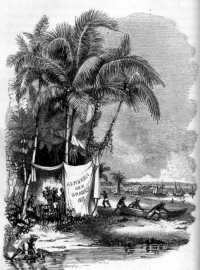 Colon, a mere collection of huts prior to the advent of
the railroad, soon became the center of considerable local trade. An open market and
non-production made it a port of entry for vessels of every flag. Colon, a mere collection of huts prior to the advent of
the railroad, soon became the center of considerable local trade. An open market and
non-production made it a port of entry for vessels of every flag.
In 1881, when operations were commenced upon the canal
works, the population rapidly increased. The town became divided in sections, the
Americans and English centering about the railroad buildings; while the canal people, not
content with mother earth, created their own town lots by driving piles out into the
bay, filling in a foundation,and on top of this terra nova laying out well graded
streets, erecting tasteful dwellings and substantial storehouses, planting trees, building
their private wharves, and altogether permanently establishing themselves for the better
advancement of canal interests. A fine hospital was erected, and completely equipped, more
efficiently to cope with the fever. Costly machinery, steam shovels, pumps, and engines
were unloaded and sent to points along the line; channel dredgers arrived and anchored in
the bay; others were sent around the Horn to Panama; coolies were imported by the
thousand; engineers were there, theodolites and all. Means were at hand to cut the
continents in two; the opportunity was theirs; and yet twelve years have passed since
operations began, and the severing stroke has not been given.
A channel partly dredged; some cuttings
here and there; a great deal of bluster; a great deal of fuss.-- officials and engineers
faultlessly arrayed in white flannels sauntered about, or puffed high-priced Havanas on
shady verandas; read the latest reports from Paris about splendid achievements on the
Isthmus, while coolies died of fever, unworked cuts caved in, engines, pumps, and other
valuable machinery, half buried in the sand, rusted and rotted themselves into a state of
uselessness.
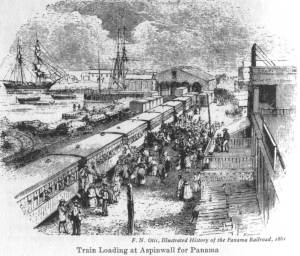
We have seen the fine buildings, the paved
streets, the substantial wharves, and other extravagances, -- now let us discover, if we
can, the raison d'etre.
As the railroad touches the line of the canal at
many points, we cannot do better than to take train for Panama, and have a look at this
gigantic failure. We start from the steamer wharf amidst a great deal of noise from
youthful fruit-vendors, and a great deal of smoke from the panting engine. The car
windows are unglazed, and sulphurous fumes have free access to roam about at will.
Nearly choked and suffocated, we pull out from under cover and roll into the sunshine, and
are soon passing through the outskirts of the town.
Fever-breeding dirt to the right of us;
fever-breeding dirt to the left of us, squalid and festering. Board-built huts with
palm-leaf thatch disgorge their dusky inmates, who tumble out to stare at us as the train
goes by. Fly-covered, hairless dogs lie reeking in the sun. Children, dressed
in nature's garb, play about in pools of mud; while in marked contrast we see gaudy
colored calicoes drying in the wind -- the wardrobes of certain maids and matrons
preparing for some gala day.
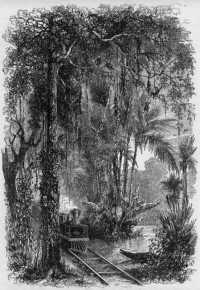 We glide smoothly along over an excellent
roadbed,-- steel rails and lignum vitć ties. We leave Colon behind us, and are soon rushing along
through dense forests of palm and cypress, made almost impenetrable by rank
undergrowth. Here by the roadside beautiful magnolias, oleanders, passion flowers,
and flowers of every hue, whose heavy perfume pervaded the car and almost intoxicates with
its overpowering sweetness. On every hand tall palms and graceful ferns bend in the
wind. Monkeys chatter, and bright plumaged birds dart from tree to tree.
We glide smoothly along over an excellent
roadbed,-- steel rails and lignum vitć ties. We leave Colon behind us, and are soon rushing along
through dense forests of palm and cypress, made almost impenetrable by rank
undergrowth. Here by the roadside beautiful magnolias, oleanders, passion flowers,
and flowers of every hue, whose heavy perfume pervaded the car and almost intoxicates with
its overpowering sweetness. On every hand tall palms and graceful ferns bend in the
wind. Monkeys chatter, and bright plumaged birds dart from tree to tree.
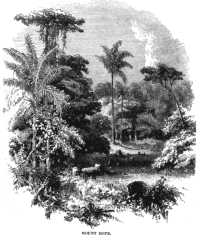 Our first stop is Monkey Hill,-- a collection of
huts and rickety buildings. We see the same calicoes, the same hairless dogs, the
same listless, lazy people. Here is located Colon's burial ground. As we pull
out we pass a funeral train, which has just arrived. The cars are gayly decked out with
fluttering streamers. The bier rests on an open flat car, covered over by an improvised
canopy. The mourners,-- natives all,-- arrayed in the gayest of costumes, are slowly
walking "all hands 'round," and droning a dismal dirge. We know now the
use of the bright calicoes, for gala days are frequent.
Our first stop is Monkey Hill,-- a collection of
huts and rickety buildings. We see the same calicoes, the same hairless dogs, the
same listless, lazy people. Here is located Colon's burial ground. As we pull
out we pass a funeral train, which has just arrived. The cars are gayly decked out with
fluttering streamers. The bier rests on an open flat car, covered over by an improvised
canopy. The mourners,-- natives all,-- arrayed in the gayest of costumes, are slowly
walking "all hands 'round," and droning a dismal dirge. We know now the
use of the bright calicoes, for gala days are frequent.
The train winds down into the
picturesque valley of the Chagres. It is here that we catch our first glimpse of the
canal workings. The river is pressed into service at many points, and this is one of
them. We see where tons of earth, taken out to widen the channel, have been washed back by
the heavy summer rains. Farther on we see a ponderous dredger foundered in the mud,
its iron arm raised high aloft, upbraiding fate and Frenchmen. Here a locomotive,
with its train of dump-cars, tipped off, and abandoned to time and the elements.
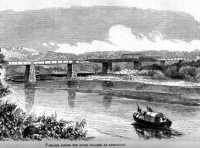 Our view is abruptly cut off as we dash into a copse of
ferns. We rattle along through this for a half mile or so, then burst out into the
open, and follow the river far a considerable distance. The train stops for a moment
at Barbacoas, then is off again, rushing around a curve, and now upon a fine bridge. We
cross the river here, and begin the ascent of a steep grade. The doughty little engine
puffs and pants as we approach the Culebra Col.
Our view is abruptly cut off as we dash into a copse of
ferns. We rattle along through this for a half mile or so, then burst out into the
open, and follow the river far a considerable distance. The train stops for a moment
at Barbacoas, then is off again, rushing around a curve, and now upon a fine bridge. We
cross the river here, and begin the ascent of a steep grade. The doughty little engine
puffs and pants as we approach the Culebra Col.
This chain of low hills forms the watershed of
the Isthmus. Being much nearer the south than the north, the streams flowing into
the Pacific are of comparatively little importance, while the Chagres, on the Atlantic
slope, with one or two small tributaries, forms a navigable river, whose volume attains
formidable dimensions during the rainy season.
The heavy floods of the river and the rocky
barrier of the Col have proved to be insurmountable obstacles thus far. The idea of
tunneling the hill was abandoned; and of the two alternatives,-- constructing a series of
locks, or making a huge cutting through the solid strata, -- neither was adopted. The
river continues to overflow its banks, and the Col remains uncut.
We reach the summit, make a short stop at
Culebra, get out to stretch our legs, and enjoy a
fine view of the valley below us. A little stream at the bottom winds along like a
silvery thread, and loses itself among the trees. A duster of thatched roofs peeps
out from the midst of a small copse of magnolias. A pretty villa, saucily
perched high up on the hillside, glistens in the sun.
We are off again, and are soon traveling along at a rapid
rate on the down grade. We leave the line of the canal far behind as we
swing off to the east. Now we see, for the first time, the western ocean; a
beautiful blue expanse of water, framed as it were by the hills and sky. We are rapidly
approaching Panama; one or two stops more and we shall be there. We left Colon at
half past eleven, and it is now after two. The sun is high in the heavens, and
it is toward the west, and behind us; while before us, to the east, the broad Pacific lies
in apparent contradiction to all geographical order.
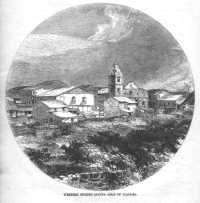 A bend in the road, and we see the towers of the old
Spanish city outlined against the clear sky. The train clatters along through the outlying
districts. The houses improve as their number increases. No more thatch roofs, but
tile-covered adobes, quaint and picturesque in groups here and there. The whistle
blows for the station. Bags are gathered up. All is commotion. We have crossed
the Isthmus, and are at our journey's end.
A bend in the road, and we see the towers of the old
Spanish city outlined against the clear sky. The train clatters along through the outlying
districts. The houses improve as their number increases. No more thatch roofs, but
tile-covered adobes, quaint and picturesque in groups here and there. The whistle
blows for the station. Bags are gathered up. All is commotion. We have crossed
the Isthmus, and are at our journey's end.
We set out in hopes of seeing much, and saw little.
We anticipated a great deal, and have been disappointed. The "raison ' d'
ętre" did not materialize. There was no canal.
Display and great pretensions do not make canals.
Over $350,000,000 have been sunk in the gigantic failure. Hundreds have been ruined
by it; hundreds have lost their lives. The sequel has been a sad one. Total failure
of the project, disgrace of its projectors, and the humiliation of a nation.
Philip Stanford.
July 1893
Back to Panama Railroad
Travelogues
Next Travelogue
|


|

